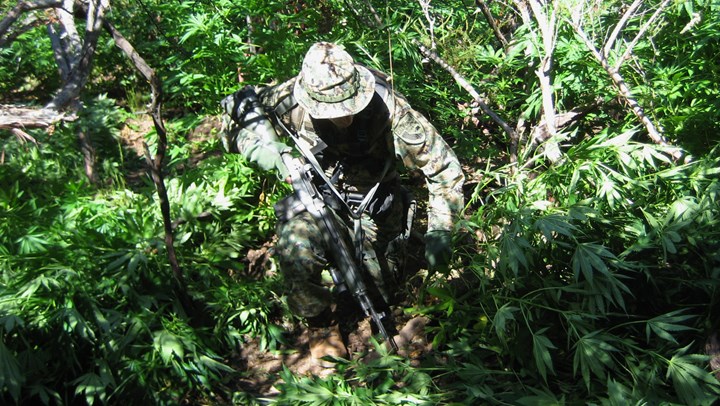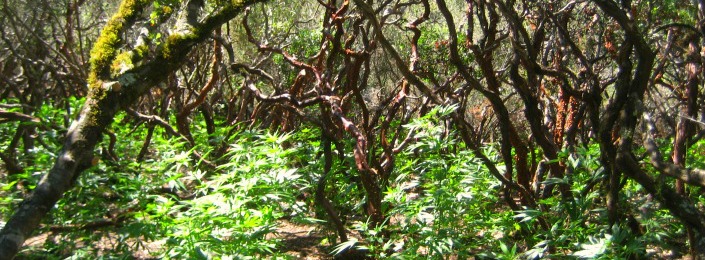
by James A. Swan, Ph.D. - Sunday, October 2, 2016

How's this for a hunting scenario? Suppose you are walking through the woods, looking for big or small game, and you suddenly see a line of black plastic irrigation tubing laying on the ground. You stop and consider it. Is this garbage, some kind of irrigation project or something else?
If you follow the irrigation tubing uphill, eventually it takes you to a source of water, most likely a stream that has been dammed and diverted to create a small reservoir. According to California Fish and Game Warden Lt. John Nores, chances are you'll also find plastic bags of illegal fertilizers and pesticides—all covered with brush—for growing plants intended for some type of human consumption.
If you track the tubing downhill, you’ll likely come upon an area where the forest's understory has been cleaned out of native plants, but the trees remain. Their canopy covers up what is taking place. Instead of an understory of native plants, you’ll find rows of chest-high plants with bright green foliage: marijuana.
Nearby are camouflaged sleeping and cooking areas, piles of garbage, propane tanks and bones of deer and bear. If you’re lucky, no one will be there. If you aren’t, the people tending this grow are all armed and linked to an international drug cartel. They do not want anyone to find their operation, which is why it’s planted in the forest. Planes and helicopters passing overhead will not spot it easily.
If You Stumble Upon a Marijuana Grow...
If you find yourself in this situation while hunting this fall, exit as quickly and quietly as possible—while remaining aware of what surrounds a marijuana grow. In addition to chicken-wire fences designed to keep out rabbits, you’ll typically find rodenticide boxes and trails with hidden pitfalls or tripwires designed to activate shotguns.
If you encounter people in the woods who don’t look like sportsmen, avoid them. Cases in point: While researching this growing problem in Mendocino County, Calif., I interviewed 15 local residents—12 of whom reported they had stumbled upon grows and been shot at while leaving the scene.
Hopefully you will never be in this scenario, but if you are, slip away and report it. If the marijuana grow is on a national forest, U.S. Fish and Wildlife Service (USFWS) wildlife refuge or BLM or state lands, call the agency that manages the land or contact the given state's game-warden-tip hotline.

California: One of Many Examples
A recent study by the California Department of Fish and Wildlife found each of four watersheds in the “Emerald Triangle” of northern California supplies water to anywhere from 23,000 to 32,000 marijuana plants. Quite a thirsty plant, a single marijuana plant needs up to 6 gallons of water per day—double the amount of water consumed by grape vines. These grows consume anywhere from 138,000 to 192,000 gallons per day.
While most of us will never encounter a marijuana grow on our hunts this fall, Lt. Nores and his tactical unit of wardens will. They are venturing into dangerous ground almost daily during the growing season that runs until early October.
Each morning on his way to work, Lt. Nores suits up with a concealed bullet-proof vest covered by a complete camouflage suit and carries a dog leash for his Lab, Apollo. Then, he straps a.40-cal. Glock pistol to his waist. His .308 black rifle and 12-gauge Remington shotgun go with him as he gets into his green Ford F-150 pickup. Nores and his team may hike into a grow they’ve spotted from the air or that hunters or hikers reported, or they may team up with a partner and high-line in—suspended on a 50-foot cable attached to a helicopter—the pilot lowers them close to a grow. The latter gets them on scene faster quicker—and hopefully scares away the growers—but they and the helicopter are also potential targets if the growers want to ambush them and fight. As they approach a grow site, if they find a grower, Nores’ team announces that they are police and orders the criminal to drop his gun. If he raises his gun, the wardens fire. If the grower drops his gun and runs, Nores and Apollo chase them down through the brush. "If you find yourself in this situation while hunting this fall, exit as quickly and quietly as possible—while remaining aware of what surrounds a marijuana grow."
California has the most grows, but the U.S. Forest Service reports that in fiscal year 2014, illegal marijuana cultivation sites were found in 72 national forests in 21 states. Other grows are found on BLM Lands, national parks and state and local parklands.
I personally got my initiation into what Lt. Nores does while my son and I were producing a documentary about California’s game wardens. On our day of baptism, we followed Lt. Nores into a regional park in the coastal range between San Jose and Palo Alto, Calif. As Nores and his team high-lined into the park’s forest, in the distance we could see the Stanford University stadium and the skyline of San Francisco.
The morning haul was 10,000 plants. Another garden in the afternoon, located on the other side of a paved road through the park, had 10,000 more plants. Nores said that at maturity, each plant is worth $1,000. Translation: The street value of the marijuana plants for that day alone was $20 million.
Marijuana Grows: By the Numbers
More than 43 percent of the nearly 3.6 million marijuana plants eradicated in 2012 were removed from more than 5,000 illegal outdoor grow sites on public and tribal lands. The Forest Service reports that in 2012 nearly 83 percent of the 1,048,768 plants eradicated from national forests were eradicated in California. Other states with significant cartel gardens on national forests, national and state parks, BLM lands and USFWS wildlife refuges include: Colorado, Oregon, Michigan, Wisconsin and Kentucky—especially in the Daniel Boone National Forest. Grow sites are typically in excess of 1,000 plants per site, sometimes consisting of more than 200,000 plants. For more information, click here.
In 2011, the Forest Service alone cleared out and restored 335 illegal cultivation sites just in California. During the clean-up, workers removed more than 130 tons of trash, 300 pounds of pesticides and 5 tons of fertilizer.
After the fall hunting seasons are over, if you belong to a local conservation organization consider helping with clean-ups on such gardens. It can cost $10,000 or more to clean up a single marijuana grow. For more details, check out the Forest Service's new brochure discussing the issue of marijuana grows in America's national forests.
E-mail your comments/questions about this site to:
[email protected]
Proudly supported by The NRA Foundation and Friends of NRA fundraising.
